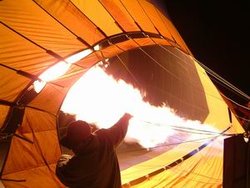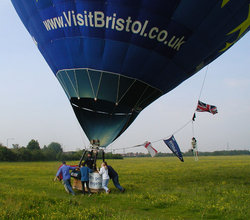Balloon (aircraft)
|
|
Balloons are a type of lighter than air aircraft that remain aloft due to their buoyancy. Balloons travel by moving with the wind. They are distinct from airships which are buoyant aircraft which can be propelled through the air in a controlled manner. They are also distinct from aerostats which are balloons that are moored to the ground rather than free flying.
| Contents |
Types of balloon aircraft
There are four main types of balloons:
- hot air balloons: obtain their buoyancy by means of heating air above the ambient temperature. They are by far the most common type of balloon aircraft today.
- gas balloons filled with an unheated gas such as:
- hydrogen - not used in airships since the Hindenburg disaster because of high flammability but still widley used in sport ballooning, some large scientific unmanned balloons and almost univerally used in weather balloon.
- helium - the gas used today for all airships and most manned balloons in the United States
- ammonia - infrequently used due to its caustic qualities and limited lift
- coal gas - used in the early days of ballooning, high flammability
- Rozier balloons: use both heated and unheated lifting gases. The most common modern use of this type of balloon is for long distance record flights such as the recent circumnavigations via balloon.
- superpressure balloons that allow the lifting gas to be pressurized in flight [with the objective of limiting or eliminating the loss of gas from day-time heating]
History
The hot air balloon was first developed as a children's toy round about the 2nd or 3rd century AD in China.
It has been proposed that some ancient civilisations developed manned hot air balloon flight. For example it has been proposed that the Nazca lines (which can only be seen from the air) presuppose some form of manned flight, and a balloon was the only possible available technology that could have achieved this. Julian Nott designed and built a balloon using woven cotton fabric and a Torta reed gondola, both readily available to the peoples who made the Nazca lines. Heating the air in the balloon with a wood fire, Nott flew over the Nazca Plains. Nott comments that there is no evidence of any kind that that ancient peoples did fly but this flight proved beyond doubt that most early civilizations could have flown: all they needed was a loom and fire.
In 1709-08-05, in Lisbon, Bartolomeu de Gusmão managed to make a balloon filled with heated air rise inside a room. Later experiments where not very successful. He made a prototype, named Passarola (Port. Big bird) and attempted to rise himself from Saint George Castle, in Lisbon, but only managed to harmlessly fall about one kilometre away.
Following Henry Cavendish's work on hydrogen, of 1766, Joseph Black proposed that a balloon filled with hydrogen would be able to rise in the air.
The first recorded manned balloon flight in history was made in a hot air balloon by the Montgolfier brothers in 1783.
Within a few days, Professor Charles made the first gas balloon flight.
Gas balloons became the most common type from the 1790s until the 1960s.
The first steerable (a.k.a. dirigible) balloon was attempted by Henri Giffard in 1852. Powered by a steam engine it was too slow to be effective. Like heavier than air flight, the internal combustion engine made dirigibles, especially blimps, practical, starting in the late ninteenth century.
Ed Yost reinvented the design of hot air balloons in the late 1950s using rip-stop nylon fabrics and high powered propane burners to create the modern hot air balloon. His first flight of such a balloon in 1960 triggered the entire modern sport balloon movement.
Balloons as flying machines
A balloon is conceptually the simplest of all flying machines. The balloon is a fabric envelope filled with a gas that is lighter than the surrounding atmosphere. As the entire balloon is less dense than its surroundings, it rises, taking along with it a basket, attached underneath, that carries passengers or payload.
The first balloons capable of carrying passengers used hot air to obtain buoyancy and were built by the brothers Josef and Etienne Montgolfier in Annonay, France.
Balloons using the light gas hydrogen for buoyancy were flown less than a month later. They were invented by Professor Jacques Charles and first flown on December 1, 1793. Gas balloons have greater lift and can be flown much longer than hot air, so gas balloons dominated ballooning for the next 200 years.
The third balloon type was invented by Pilâtre de Rozier and is a hybrid of a hot air and a gas balloon. Gas balloons have an advantage of being able to fly for a long time and hot air balloons have an advantage of being able to easily change altitude so the Rozier balloon was a hydrogen balloon with a separate hot air balloon attached. In 1785, Pilâtre de Rozier took off in an attempt to fly across the English Channel but the balloon exploded a half-hour into the flight. This unfortunate accident earned de Rozier the title "The First to Fly and the First to Die". It wasn't until the 1980s that technology once again allowed the Rozier balloons to become feasible.
Jean-Pierre Blanchard made the first piloted balloon flight in North America on January 9, 1793. Although a balloon has no propulsion system, a degree of directional control is possible through making the balloon rise or sink in altitude to find favorable wind directions.
Both the hot-air, or Montgolfière, balloon and the gas balloon are still in common use. Montgolfière balloons are relatively inexpensive as they do not require high-grade materials for their envelopes, and they are popular for balloonist sport activity.
Light gas balloons are predominant in scientific applications, as they are capable of reaching much higher altitudes for much longer periods of time. They are generally filled with helium. Although hydrogen has more lifting power, it is explosive in an atmosphere full of oxygen. With a few exceptions, scientific balloon missions are unmanned.
There are two types of light-gas balloons: zero-pressure and superpressure. Zero-pressure balloons are the traditional form of light-gas balloon. They are partially inflated with the light gas before launch, with the gas pressure the same both inside and outside the balloon. As the zero-pressure balloon rises, its gas expands to maintain the zero pressure difference, and the balloon's envelope swells.
At night, the gas in a zero-pressure balloon cools and contracts, causing the balloon to sink. A zero-pressure balloon can only maintain altitude by releasing gas when it goes too high, where the expanding gas can threaten to rupture the envelope, or releasing ballast when it sinks too low. Loss of gas and ballast limits the endurance of zero-pressure balloons to a few days.
A superpressure balloon, in contrast, has a tough and inelastic envelope that is filled with light gas to pressure higher than that of the external atmosphere, and then sealed. The superpressure balloon cannot change size greatly, and so maintains a generally constant volume. The superpressure balloon maintains an altitude of constant density in the atmosphere, and can maintain flight until gas leakage gradually brings it down.
Superpressure balloons offer flight endurance of months, rather than days. In fact, in typical operation a Earth-based superpressure balloon mission is ended by a command from ground control to open the envelope, rather than by natural leakage of gas.
GasballoonsABQ.jpg
For air transport balloons must contain a gas lighter than the surrounding air. There are two types:
- hot air balloons: filled simply with hot air, which by heating becomes lighter than the surrounding air; they have been used to carry human passengers since the 1790s;
- balloons filled with:
- hydrogen - Athough highly flammable still used in Europe (see Hindenburg disaster)
- helium - Safe but very expensive.
Large helium balloons are used as high flying vessels to carry scientific instruments (as do weather balloons), or even human passengers.
Balloons in the military
Hot air balloons were used by military observers in the American Civil War (1861-65), the most well known being Thaddeus S.C. Lowe, who headed the balloon corps from 1861-1863. The use of military observers in balloons during the Civil War resulted in a warfare first, when Union guns fired on the Confederates using only the intel that the aeronaut provided, and without seeing the enemy for themselves. Hydrogen-filled ballons were also widely used during World War I (1914-1918) to detect enemy troop movements and to direct artillery fire. Observers phoned their reports to officers on the ground who then relayed the information to appropriate destinations. Because artillery was such an important factor in WW I, balloons were frequent targets of opposing aircraft. Though balloon companies of all combatants were protected by antiaircraft guns and patrolling fighters, casualties frequently were heavy.
The Aeronaut Badge was established by the United States Army in World War I to denote service members who were qualified baloon pilots. Observation balloons were retained well after the Great War, being used in the Russo-Finnish conflicts (1939-40 and 1941-45).
The Japanese launched thousands of balloon bombs to the US and Canada, carried in the jet stream; see fire balloons. Also, the British used balloons to carry incendiary devices to Germany between 1942 and 1944, see Operation Outward.


